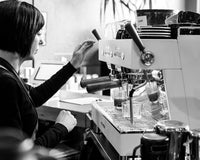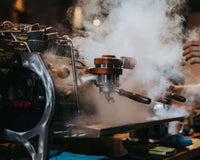WHY USE A THERMOFILTER/SCACE?
The measurement of the temperature of water dispersed from an espresso machine can be challenging. One of the most important aspects to consider is where the temperature of water is measured from. While the temperature of the water inside the machine is important, the Scace tool focuses on the temperature of the water at the coffee. Great attention must be paid to ensuring the tool used to measure the temperature does not in fact affect the temperature of the coffee. A fast responding electric thermal probe is the best option in the case of espresso. The Scace tool uses a thermal probe mounted to a modified portafilter basket inside of a modified portafilter. Having the probe mounted to the device ensures ease of use and consistency while minimizing margin of error. A temperature reading device is necessary to get a read out from the thermal probe.
The Scace uses a Type 2 PVC plastic insert in place of a coffee puck to be sure the probe only comes into contact with water and no other contaminants. In addition, the plastic insert removes the possibility of variations in dosing, water flow rate, and preserves the same measurement as it would be incredibly difficult to ensure the sheathed probe’s position above the puck. There is also a flow restrictor in place to simulate the rate of flow through a shot conforming to specifications presented by the SCA.
HOW TO USE THE THERMOFILTER/SCACE?
The following procedure is intended to provide a standard of measuring water temperature on a single group.
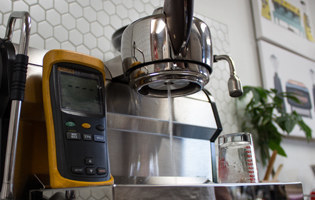
In preparation you must first backflush the machine prior to testing. It’s best to remove the screen and thoroughly clean both the screen and the group head before beginning testing. Cleaning the groups minimizes the possibility that any stray coffee grinds will clog the flow restrictor, thereby affecting the flow rate, and ultimately the temperature measurement. After the backflushing is complete, the machine must sit at idle to insure the machine is at normal operating temperature before testing.
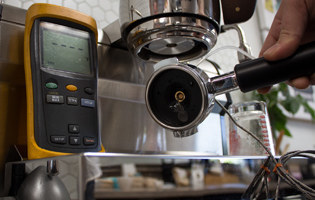
1. The machine must sit at rest for one hour prior to testing. The Scace device must be engaged with the group head of the machine during this time
2. The Scace shall be removed for fifteen seconds to simulate dosing and tamping. The group will then be flushed for two seconds just before reinserting the Scace to simulate a group flush.
3. Temperature measurement should begin immediately. Brewing will be activated in a manner consistent to the the regular use of the machine. 75ml ± 5% of water shall pass through the Scace. The initial three seconds of brew time will be disregarded. During this time there is a lag with the thermometer and ignoring this data will negate the lag in the results.
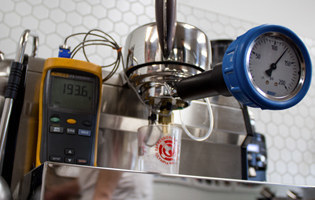
4. The data collected during the brew cycle should be recorded. A datalogger is preferable.
5. Immediately following the test the Scace should be removed for ten seconds and the group flushed for two seconds. The following idle interval shall then be observed between each test:
| Test Point | (mm:ss) |
|---|---|
| 1 | 10:00 |
| 2 | 05:00 |
| 3 | 02:00 |
| 4 | 02:00 |
| 5 | 01:00 |
| 6 | 01:00 |
| 7 | 00:30 |
| 8 | 00:30 |
| 9 | 00:10 |
| 10 | 00:10 |
| 11 | 00:10 |
| 12 | 00:10 |
| 13 | 00:10 |
| 14 | 00:10 |
6. Simulated Disposal of the Coffee Cake: Immediately after simulated brewing is complete, the portafilter shall be removed for approximately 10 seconds, during which the group shall be flushed for 2 seconds. The portafilter shall be reinstalled and the test shall proceed to the next idle interval.
PRO TIP:
The substantial flushing of groups between shots had been intentionally left out of the testing procedure. The intent of the study of your machine is to determine if those cooling cycles are necessary, and to what extent, and the result of ignoring the potential need for the cooling flushes. The determination of the best flushing flushing procedure can be determined separately after a standard has been realised.
The average brew temperature shall be the temperature observed most during the brew cycles.
THERMOFILTER & ESPRESSO TEMPERATURE FAQS
What temperature should espresso be brewed?
The ideal temperature for espresso to be brewed at is around 190-200°F. When brewing espresso, ensure the water does not reach its boiling point (212°F) as it will result in a bitter and burnt coffee taste.
How do I check the temperature of my espresso?
You can measure the temperature of espresso by using a thermofilter. The Scace 2 Thermofilter available on Espresso Parts gives you both temperature and pressure readings directly at the group.




